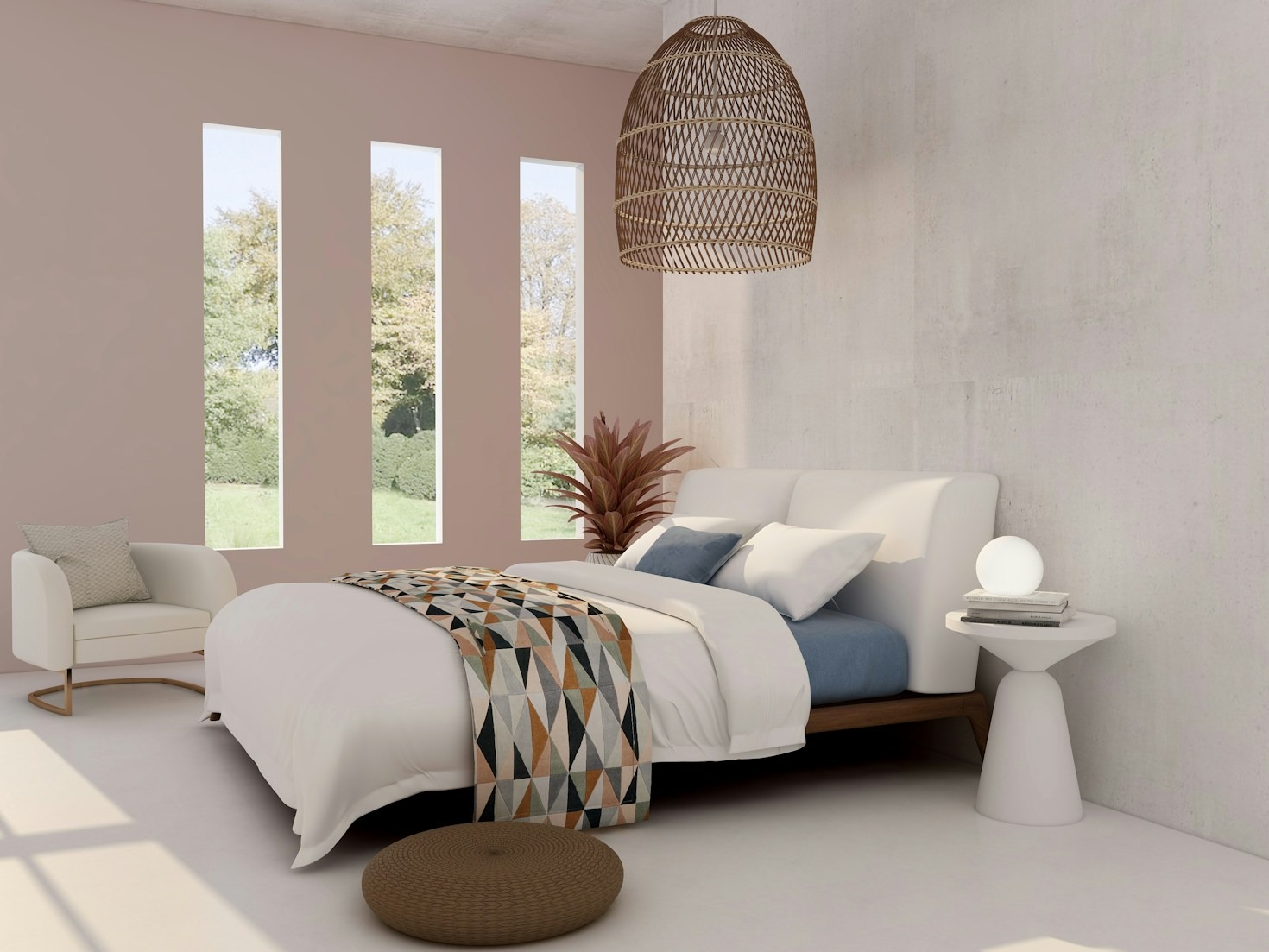Bedroom makeovers that inspire relaxation have become my personal obsession ever since I realized how much my sleep environment was affecting my overall wellbeing. I used to think that my restless nights were just part of adult life, until I discovered that the bright red accent wall and cluttered nightstand in my bedroom were actually working against my brain’s natural wind-down process.
The moment I learned that certain colors can reduce stress levels and promote relaxation, everything clicked. My bedroom wasn’t just a place to crash at night – it was supposed to be my personal sanctuary, a space that actively supports rest and rejuvenation.
That’s when I dove deep into the fascinating world of bedroom design psychology, discovering how everything from paint colors to furniture placement can transform a chaotic sleeping space into a peaceful retreat. Let me share what I’ve learned about creating a bedroom that truly nurtures your need for rest.
The Color Connection: How Paint Colors Transform Your Sleep Quality
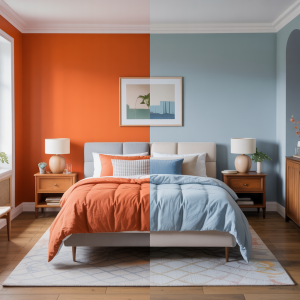
I never believed that something as simple as wall color could dramatically change my sleep until I experienced it firsthand. After years of struggling with restless nights in my vibrant orange bedroom (what was I thinking?), I finally discovered the fascinating science of color psychology – and let me tell you, it’s been a complete game-changer.
Here’s what blew my mind: our brains actually process colors as signals that trigger specific physiological responses. When I learned that cool-toned colors can literally lower your heart rate and blood pressure, everything started making sense.
My body wasn’t just being dramatic – it was responding to environmental cues I’d been completely ignoring.
The Science Behind Sleep-Inducing Colors
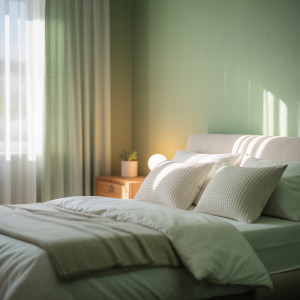
Let me break down what actually happens when you surround yourself with the right colors. Cool tones like soft blues and sage greens work like a natural sedative for your brain.
These colors have shorter wavelengths that signal to your nervous system that it’s time to wind down. I’ve found that painting my walls a soft powder blue created an immediate shift in how quickly I could relax after a stressful day.
The research backs this up beautifully. Studies from the University of Sussex found that exposure to certain colors can significantly reduce stress levels and promote relaxation.
Even more impressive? One survey discovered that people with blue bedrooms averaged the longest sleep duration compared to those with different colored rooms.
I’m talking about actual, measurable improvements in sleep quality – not just feeling like you slept better.
My Personal Color Journey: From Chaos to Calm
When I first started experimenting with bedroom colors, I made the mistake of going too dark with a navy accent wall. While navy can work beautifully for some people, I found it made my small bedroom feel cave-like, especially during winter months.
The key lesson I learned? It’s not just about choosing a “relaxing” color – it’s about finding what works for your specific space and personal response.
I eventually landed on a combination of soft sage green walls with white trim, and the transformation was immediate. Sage green brings that perfect balance – it’s grounded and earthy without being too stimulating.
Every morning, I wake up feeling like I’m in a peaceful forest retreat rather than my third-floor apartment. Friends who visit often comment on how instantly calm they feel in my room, which tells me it’s not just my imagination.
The Colors That Actually Work (And Why)
Through my research and personal testing, I’ve discovered that certain colors consistently deliver better sleep results. Soft blues remain the undisputed champion – they’re associated with trust and honesty, which helps your brain feel safe enough to fully relax.
I particularly love how morning light plays with pale blue walls, creating an almost ethereal quality that makes waking up feel less jarring.
Pale greens offer something special too. They connect us to nature in a way that feels instinctive and grounding. When I helped my sister redesign her bedroom with soft mint walls, she reported feeling more refreshed in the mornings – that rejuvenating quality that green brings really does translate into better sleep recovery.
Don’t overlook warm neutrals either! Colors like ivory, oatmeal, and soft taupe create what I call a “blank canvas for the mind”. They’re particularly effective if you’re someone who gets easily overstimulated.
My friend with ADHD swears by her cream-colored bedroom – she says it’s the only space where her mind can truly quiet down.
The Surprising Power of Pink
Here’s something that caught me off guard: soft pinks and blush tones can be incredibly effective for relaxation. Initially, I was skeptical – wouldn’t pink be too stimulating?
But psychologists actually request light pink for their offices because it creates an environment where people naturally feel at ease. I tested this theory with blush curtains and dusty rose throw pillows, and the warmth they added without any energizing effect was remarkable.
Colors to Absolutely Avoid
Now, let me save you from my mistakes. Red walls?
Terrible idea. Orange accents?
Unless you want to feel like you’re sleeping in a gym, skip them. These warm, high-energy colors literally signal your brain to stay alert.
Even bright yellows, which seem cheerful during the day, can interfere with your ability to wind down at night.
I learned this the hard way when I thought a “sunset orange” feature wall would be cozy. Instead, I spent months wondering why I felt wired every time I entered my bedroom.
The moment I painted over it with a soft gray-blue, my sleep improved within days. Sometimes the most powerful changes are the ones that remove problems rather than add solutions.
Lighting Magic: Creating Your Perfect Sleep Sanctuary
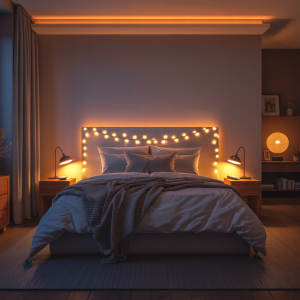
Oh my goodness, can we talk about lighting for a minute? I used to think bedroom lighting was just about having a lamp next to my bed, but wow, was I missing out on something incredible!
Once I discovered how dramatically lighting affects our ability to relax and sleep, I went down this amazing rabbit hole of research – and honestly, it changed everything about how I approach my evening routine.
The Science That Made Me a Lighting Convert
So here’s what completely fascinated me: our bodies have this internal clock called the circadian rhythm, and it’s basically controlled by light exposure. When I learned that bright light can literally suppress melatonin production (that’s our natural sleep hormone), I finally understood why scrolling through my phone in bed was such a terrible idea.
Blue light is especially problematic – it has this short wavelength that tells our brain “hey, it’s still daytime!” even when it’s midnight.
The research on this is mind-blowing. There was this study from 2022 that showed depressed patients who had dynamic bedroom lighting actually slept 27 minutes longer and woke up feeling more refreshed.
Twenty-seven minutes! That might not sound like much, but trust me, when you’re sleep-deprived, that extra half hour feels like winning the lottery.
My Three-Layer Lighting Revolution
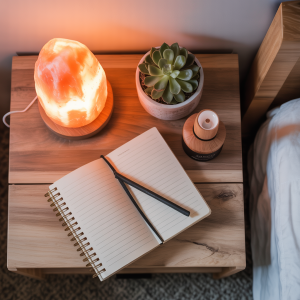
Let me share the game-changing concept that transformed my bedroom: layered lighting. Instead of relying on that harsh overhead fixture (seriously, why do builders think one bright light in the center of the ceiling is enough?), I created three distinct lighting layers that work together like a dream team.
First, there’s ambient lighting – this is your foundation. I installed dimmable warm LED bulbs in my ceiling fixture, keeping them at 2700K to 3000K color temperature.
These warmer tones are absolutely essential because they support our natural sleep cycles rather than fighting against them. The difference from my old cool white bulbs was immediate – no more feeling wired when I should be winding down!
Next comes task lighting, which has been a total lifesaver for my nighttime reading habit. I found these perfect bedside lamps that sit at eye level when I’m propped up in bed.
My partner loves this setup because I can read without disturbing his sleep – marriage saver right there! The key is positioning them so they don’t create harsh shadows or glare.
The accent lighting layer is where things get really fun and cozy. I strung these warm LED fairy lights behind my headboard, and added a small Himalayan salt lamp in the corner.
These create such a dreamy atmosphere without overwhelming the space. It’s like having a permanent sunset in my room!
The Evening Dimming Ritual That Changed Everything
Here’s something that sounds almost too simple to work, but it’s been absolutely transformative: I start dimming my lights gradually about an hour before bed. This mimics a natural sunset and signals to my brain that sleep is coming.
I literally set a reminder on my phone (ironic, I know!) to start this process at 9 PM.
The gradual transition makes such a difference compared to suddenly switching from bright lights to darkness. Our bodies naturally react to these light fluctuations, and when you go from super bright to pitch black instantly, it’s actually pretty jarring for your system.
Now I use my dimmer switches like they’re my personal sleep coaches, slowly guiding me toward bedtime.
Smart Solutions That Don’t Break the Bank
When I first started researching smart lighting, I thought it would cost a fortune, but I’ve found some incredible budget-friendly options! Smart bulbs that you can control with your phone start at around $15 each, and they’re worth every penny.
I programmed mine to automatically start dimming at sunset and gradually brighten in the morning – it’s like having a personal sunrise and sunset service!
For those middle-of-the-night bathroom trips (we all have them!), I installed these motion-sensor LED strips under my bed that emit a soft amber glow. They provide just enough light to navigate safely without fully waking up my brain or disrupting my melatonin production.
My mom visited recently and loved this feature so much she immediately ordered some for her own bedroom!
The Colors That Actually Help You Sleep
Through all my experimenting, I’ve discovered that warm colors are absolutely non-negotiable for bedroom lighting. Those orange, red, and yellow tones are so much gentler on our eyes and don’t interfere with melatonin production like cooler colors do.
I specifically look for bulbs labeled “warm white” or those around 2200K to 2700K – anything cooler than 3000K is basically telling your brain it’s party time when you should be sleeping.
One surprising discovery? Even if lights appear equally bright, their wavelengths can affect us differently.
This explained why my old “daylight” bulbs made me feel so alert at night – they were mimicking actual daylight, which can reach 10,000 lux in direct sunlight!
Real-Life Lighting Wins
Let me tell you about my friend Sarah’s transformation. She’s a nurse who works rotating shifts and was struggling terribly with sleep.
We installed blackout curtains and replaced all her bedroom bulbs with warm, dimmable LEDs. Within two weeks, she was falling asleep 20 minutes faster and reported feeling more rested even with her crazy schedule.
The blackout curtains were especially crucial for blocking that morning light when she needed to sleep during the day.
Another success story: my brother, who’s always been a night owl, started using blue light blocking mode on all his devices after 8 PM and switched to warm amber reading lights. He went from lying awake until 2 AM to naturally feeling sleepy by 11 PM.
The change was so dramatic that his wife jokes about sending me a thank-you card!
The Bedding Revolution: Investing in Your Sleep Comfort
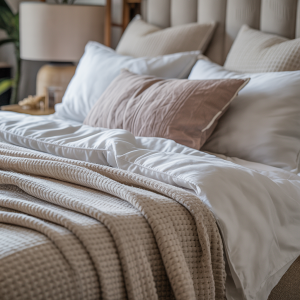
Okay, let’s get real about bedding because this is where I had my biggest “aha” moment! I spent years sleeping on the same scratchy sheets from college, wondering why I’d wake up feeling like I’d wrestled a bear all night.
Then I finally splurged on quality bedding, and honestly? It was like discovering I’d been sleeping wrong my entire adult life!
The Touch Test That Changed My Perspective
Here’s something wild that completely shifted how I think about bedding: our skin is our largest organ, and it’s constantly sending signals to our brain about our environment. When I realized that rough, synthetic fabrics were literally keeping my nervous system on alert all night, everything clicked.
My body wasn’t being dramatic – it was responding to thousands of tiny irritations I couldn’t consciously feel!
The science behind this is fascinating. Research from the National Sleep Foundation shows that 73% of people say they sleep better on sheets with a fresh scent and comfortable feel.
But here’s what really got me: studies have found that certain fabrics can actually regulate body temperature throughout the night, preventing those annoying 3 AM wake-ups when you’re either freezing or sweating.
My Journey Through the Fabric Universe
Let me take you through my bedding adventure because I’ve tried pretty much everything at this point! I started with basic polyester sheets (budget-friendly but oh-so-wrong for me), moved through microfiber (better but still not quite right), and finally discovered the magic of natural fibers.
Cotton percale became my first love in the natural fiber world. These sheets feel crisp and cool, almost like sleeping in a fancy hotel every night.
They’re particularly amazing if you’re a hot sleeper like my partner – he literally sighs with relief when he slides into our percale sheets after a long day. The breathability factor is unreal; it’s like the sheets are actively working to keep you comfortable!
But then I discovered bamboo sheets, and wow, talk about a game-changer! They’re naturally moisture-wicking and temperature-regulating, plus they have this silky smooth texture that feels absolutely luxurious.
My sister with sensitive skin swears by them – she says they’re the only sheets that don’t irritate her eczema.
Thread Count Myths That Need to Die
Can we please talk about the thread count obsession? I used to think higher was always better, hunting for those 1000-thread-count sheets like they were the holy grail of sleep.
But here’s what nobody tells you: anything above 400-600 thread count is often just marketing nonsense! Those super high counts usually mean they’re using thinner, lower-quality threads or counting them in sneaky ways.
What really matters is the quality of the fibers and the weave. I have 300-thread-count percale sheets that feel infinitely better than the 800-count sateen ones I bought thinking I was being fancy.
The percale ones breathe better, last longer, and actually get softer with each wash. Meanwhile, those high-count sheets ended up feeling heavy and suffocating – definitely not the relaxation vibe we’re going for!
The Pillow Paradise Discovery
Oh my goodness, pillows! This is where I went completely overboard, but in the best way possible.
I used to be a one-pillow person, thinking multiple pillows were just for decoration. Then I learned about proper sleep positioning and how the right pillow setup can eliminate neck pain, reduce snoring, and improve breathing.
I now have what my friends call my “pillow system” – a firm memory foam pillow for neck support, a softer down alternative for cuddling, and a wedge pillow for those nights when allergies make breathing difficult. The transformation in my sleep quality was immediate.
No more waking up with a stiff neck or that awful pins-and-needles feeling in my arms!
The research on this is compelling too. Studies show that using the wrong pillow height can reduce blood flow to the brain by up to 20%.
Twenty percent! That explains why I used to wake up with those terrible morning headaches.
The Weighted Blanket Revelation
I was super skeptical about weighted blankets – they seemed like such a trend! But when my anxiety started affecting my sleep, I decided to give one a try.
The science behind them is actually beautiful: they provide deep pressure stimulation, which triggers the release of serotonin and reduces cortisol levels.
I started with a 15-pound blanket (the recommendation is about 10% of your body weight), and the first night was magical. It felt like getting a full-body hug that lasted all night.
My racing thoughts slowed down, and I fell asleep faster than I had in months. Even my skeptical husband tried it and admitted it helped him feel more grounded and calm.
Seasonal Bedding Switches That Make Sense
Here’s something I wish someone had told me earlier: rotating your bedding seasonally isn’t just about temperature – it’s about creating variety that keeps your bedroom feeling fresh and inviting! I switch to flannel sheets and a down comforter in winter, creating this cozy cocoon that makes me actually excited for bedtime.
In summer, I go full tropical with lightweight linen sheets and a cotton coverlet.
This rotation has psychological benefits too. My brain associates different textures with different seasons, which helps maintain that bedroom excitement throughout the year.
Plus, giving your bedding a break extends its lifespan – my percale sheets have lasted three years and still feel amazing because they get a six-month rest each year!
Your Dream Bedroom Awaits: Start Tonight
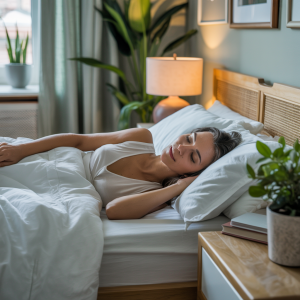
After transforming my own bedroom into a true relaxation sanctuary, I can honestly say that every single change was worth the effort.
The journey from restless nights to peaceful sleep didn’t happen overnight, but each small improvement built upon the last, creating a compound effect that’s transformed not just my sleep, but my entire daily energy and mood.
You don’t need to tackle everything at once. Start with one element that resonated most with you – maybe it’s switching to warmer light bulbs tonight, or ordering those bamboo sheets you’ve been considering.
These changes will ripple into better sleep quality, reduced stress levels, and mornings where you actually feel refreshed.
Your bedroom should be your personal retreat from the world’s chaos. By implementing even a few of these science-backed strategies, you’ll create a space that actively supports your wellbeing.
Tonight, choose one thing to change. Your future self will thank you every single morning.

